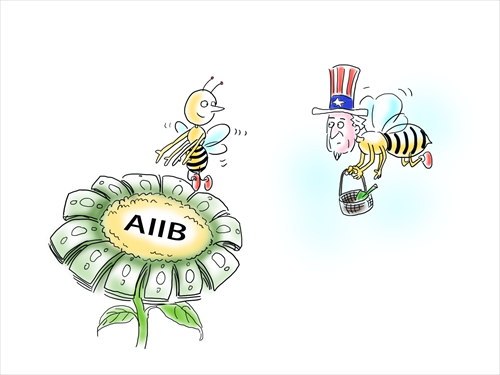HOME >> OP-ED
AIIB programs offer fresh chance for Sino-US cooperation efforts
By Zhao Minghao Source:Global Times Published: 2016-4-27 19:48:01

Illustration: Liu Rui/GT
During this year's annul spring meetings of the World Bank (WB) Group and the International Monetary Fund, the Asian Infrastructure Investment Bank (AIIB) and the WB signed a co-financing framework agreement to jointly fund major infrastructure projects in regions including Central Asia and South Asia. The AIIB in 2016 is anticipated to approve $1.2 billion in loans, with joint projects with WB and Asian Development Bank (ADB) accounting for a sizable share.
Jin Liqun, president of the AIIB, noted that the AIIB would only invest in projects that meet its standards of "financially sustainable, environmentally friendly and socially acceptable," and that those projects won't exclude non-AIIB members such as the US.
This indicates China is endeavoring to fulfill its commitments to the AIIB that make the new international multilateral mechanism "lean, clean and green." It is estimated that the global demand for infrastructure investment can amount to more than $90 trillion over the next 15 years. This means the annual investment in infrastructure has to rise to $6 trillion from the current $2.5-3 trillion. Investment in Asia will make up the lion's share. Nearly 1.6 billion people now are plagued by electricity shortages in South Asia.
The AIIB defines infrastructure in a broader sense. Besides basic facilities and installations, it will also invest in such areas as health and education. As Zia Qureshi, senior fellow at Brookings Institute said, the AIIB supports an "infrastructure for a sustainable future."
As global powers, both China and the US should bear responsibilities for promoting international development. Regrettably, the US is not only sharply reducing its input in facilitating others' development, but also has misgivings about China, if not hostility.
Unpleasant episodes such as the South China Sea disputes shouldn't seriously distract policymakers from cooperation. Former commander of the US Pacific Command Samuel J. Locklear III once said the biggest long-term security threat in the Asia-Pacific region is climate change. People in this region will suffer from a worsening climate and have to face myriad climate-related development challenges.
The entangled relationship between development and security problems has increasingly become a conundrum that governments need to tackle. More than half of the population of Kazakhstan are young, and youth unemployment creates the soil for the spread of religious extremism. Without a legitimate and stable income, numerous Afghans secure a living by joining the Taliban or planting poppies. The most effective weapons to deal with terrorism and extremism are trade and job opportunities rather than missiles and drones.
Undoubtedly, both China and the US have to think seriously about how to build a global development partnership that will benefit both as well as the whole world. The "Belt and Road" initiative has offered a rare change that deserves Washington's support.
In March last year, US Deputy Secretary of State Antony Blinken delivered a speech titled "An Enduring Vision for Central Asia" at the Brookings Institute. He said "We don't see China's involvement in Central Asia in zero-sum terms. Its development of infrastructure in Central Asia can be fully complementary to our own efforts." More than 20 countries that the "Belt and Road" initiative covers either have US troops stationed on their territory or have military alliances with the US. Over 10 of the US non-NATO allies are in the region. As the initiative expands, many of its projects will also involve NATO countries, since it covers 13 out of the 28 NATO members.
The US has also promoted some regional development cooperation projects, such as the New Silk Road initiative envisioned in 2011, Indo-Pacific Economic Corridor, US-Asia Pacific Comprehensive Energy Partnership and the Lower Mekong Initiative and so on. Obviously, China and the US have many of their goals overlapping and need to tap the potential for cooperation.
China has taken the initiative in Africa. It invited the US to jointly finance the $12 billion Inga 3 dam in the Democratic Republic of Congo. It is also considering offering support for the plan to power Africa proposed by the Obama administration. Washington needs to acknowledge the significant role China plays in international economic growth and development, responding to Beijing's initiative in a wiser way. The cooperation between the AIIB and WB on infrastructure offers people hope.
The author is a research fellow at the Charhar Institute and an adjunct fellow at the Chongyang Institute for Financial Studies at Renmin University of China. opinion@globaltimes.com.cn Follow us on Twitter @GTopinion
Posted in: Viewpoint